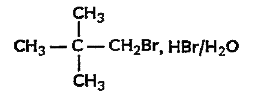What would be the reactant and reagent used to obtain 2,4 - dimethylpentan-3-ol ?
Propanal and proyl magnesium bromide
3-Methybutanal and 2- methyl magnesium iodide
2,2-Dimethylpropanone and methyl magnesium iodide
2- Methylpropanal and isopropyl magnesium iodide
The correct Answer is:D
To obtain 2,4-dimethylpentan-3-ol, we need to identify the appropriate reactant and reagent. Here’s a step-by-step breakdown of the solution:
Step 1: Identify the Target Compound
The target compound is 2,4-dimethylpentan-3-ol. This indicates that we need a pentane backbone (5 carbon atoms) with two methyl groups on the 2nd and 4th carbon and an alcohol (-OH) group on the 3rd carbon.
Step 2: Determine the Structure of the Reactant
To synthesize this compound, we can start with a suitable ketone or aldehyde that can be converted into the desired alcohol. A good starting point is 2-methylpropan-2-ol, which has a structure that can be modified to yield the target compound.
Step 3: Select the Grignard Reagent
To introduce the required carbon chain and functional group, we can use a Grignard reagent. The Grignard reagent we will use is isopropyl magnesium iodide (C3H7MgI), which will add to the carbonyl compound.
Step 4: Reaction Mechanism
1. Formation of the Grignard Reagent: Isopropyl magnesium iodide is formed from isopropyl bromide and magnesium in dry ether.
2. Nucleophilic Addition: The Grignard reagent will act as a nucleophile and attack the carbonyl carbon of the ketone (or aldehyde), leading to the formation of an alkoxide intermediate.
3. Protonation: Upon hydrolysis (adding water), the alkoxide will be converted to the corresponding alcohol, yielding 2,4-dimethylpentan-3-ol.
Step 5: Final Product Confirmation
After the reaction, we will confirm that the product formed is indeed 2,4-dimethylpentan-3-ol by checking the structure and ensuring that the methyl groups are on the correct carbon atoms and that the alcohol is on the 3rd carbon.
Summary of Reactants and Reagents
- Reactant: 2-methylpropan-2-ol (or a suitable ketone/aldehyde)
- Reagent: Isopropyl magnesium iodide (C3H7MgI)
The target compound is 2,4-dimethylpentan-3-ol. This indicates that we need a pentane backbone (5 carbon atoms) with two methyl groups on the 2nd and 4th carbon and an alcohol (-OH) group on the 3rd carbon.
To synthesize this compound, we can start with a suitable ketone or aldehyde that can be converted into the desired alcohol. A good starting point is 2-methylpropan-2-ol, which has a structure that can be modified to yield the target compound.
To introduce the required carbon chain and functional group, we can use a Grignard reagent. The Grignard reagent we will use is isopropyl magnesium iodide (C3H7MgI), which will add to the carbonyl compound.
1. Formation of the Grignard Reagent: Isopropyl magnesium iodide is formed from isopropyl bromide and magnesium in dry ether.
2. Nucleophilic Addition: The Grignard reagent will act as a nucleophile and attack the carbonyl carbon of the ketone (or aldehyde), leading to the formation of an alkoxide intermediate.
3. Protonation: Upon hydrolysis (adding water), the alkoxide will be converted to the corresponding alcohol, yielding 2,4-dimethylpentan-3-ol.
After the reaction, we will confirm that the product formed is indeed 2,4-dimethylpentan-3-ol by checking the structure and ensuring that the methyl groups are on the correct carbon atoms and that the alcohol is on the 3rd carbon.
- Reactant: 2-methylpropan-2-ol (or a suitable ketone/aldehyde)
- Reagent: Isopropyl magnesium iodide (C3H7MgI)
Topper's Solved these Questions
- ALCOHOLS,PHENOLS AND ETHERSBOOK - NCERT FINGERTIPSCHAPTER - ALCOHOLS,PHENOLS AND ETHERSEXERCISE - Some Commercially Important Alcohols
4 Videos
- ALCOHOLS,PHENOLS AND ETHERSBOOK - NCERT FINGERTIPSCHAPTER - ALCOHOLS,PHENOLS AND ETHERSEXERCISE - Ethers
17 Videos
- ALCOHOLS,PHENOLS AND ETHERSBOOK - NCERT FINGERTIPSCHAPTER - ALCOHOLS,PHENOLS AND ETHERSEXERCISE - Structures Of Functional Groups
2 Videos
- ALDEHYDES, KETONES AND CARBOXYLIC ACIDSBOOK - NCERT FINGERTIPSCHAPTER - ALDEHYDES, KETONES AND CARBOXYLIC ACIDSEXERCISE - Assertion And Reason
15 Videos
Similar Questions
Knowledge Check
2, 4-Dimethyl pentan -3-ol is a
Aprimary alcoholBsecondary alcoholCtertiary alcoholDdihydric alcoholName the reactant and reagent used to obtain n-propyl alcohol:
A B
B C
C D
D
Which of the following sets of reactants may be used to prepare 2-methylbutan-2−ol?
APropanal and isopropylmagnesium bromideBButanone and methylmagnesium iodideCPropanone and ethylmagnesium iodideDEither of the above two
The calcium salt of which the following acid on dry distillation gives 2, 4-dimethylpentan-3-one?
View SolutionThe calcium salt of which of the following acid on dry distillation gives 2, 4-dimethylpentan-3-one?
View SolutionWhich of the following pairs of reagents would give 4-methyl 2 pentanol ?
View SolutionWhich of the following pairs of reagents would give 4 -methyl-2-pentanol?
View SolutionThe number of chiral centres present in 3,4-dichloropentan−2−ol is
View Solution
